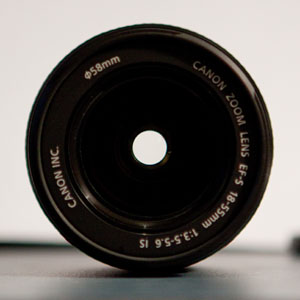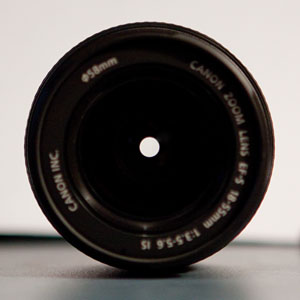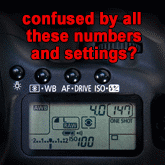posted Monday, 10 January 2011, 09:50 (+0800), by Martin
This is the sixth article in a
series on "understanding your camera"
that I am writing as I teach camera basics and camera operation to my children.
It has been a little while since the previous post in this series. I am hoping to publish additional articles in this series a little more regularly this year.
Before looking at camera controls and camera operation, I want to first re-visit the concept of f-numbers, f-stops and stops, as an understanding of these is important for further posts in this series.
The f-number is the ratio of aperture to the focal length, because the area of the aperture opening changes with focal length.
It can be calculated as the ratio of the focal length to the diameter of the aperture opening, ie,
This allows you to calculate the f-number (aperture number) for a given focal length and aperture diameter, or alternatively, to calculate the aperture diameter for a given f-number and focal length. For example, this equation allows us to calculate that a 50mm lens at an aperture of f/2 will have the lens aperture opened to a diameter of 25mm.
The larger the maximum aperture of a lens, the larger the physical size of the lens, as the size of the aperture opening is larger. That is why the Canon EF 70-200 f/2.8L lens is larger diameter than Canon EF 70-200 f/4L lens. Not only does the f/2.8 version have a larger outer diameter than the f/4 version (77mm filter size vs 67mm filter size), but it is also heavier (1409gr vs 760gr), and more expensive (USD$2069 vs USD$1189), due to the larger (and more) glass elements in the faster lens.
This definition also means that for a fixed aperture setting, the size of the aperture opening on a zoom lens will vary as the focal length is varied.
For example, the size of the aperture opening on the Canon EF-S 18-55mm IS lens at f/5.6 will be larger when zoomed to 55mm than it will be at 18mm, as shown in the two images below:
The f-number (and hence the aperture) on lenses can be adjusted in discrete steps that are referred to as "f-stops". An f-stop represents a halving or doubling of the amount of light allowed through the lens, by halving or doubling the area of the aperture opening (as described in an earlier article in this series on aperture).
The term "f-stop" is often abbreviated to "stop". Other exposure parameters are also typically expressed in terms of "stops", so you will often hear or read about photographers referring to adjusting shutter speed and ISO in "stops".
In photography, a "stop" is really just a unit used to measure ratios of light or exposure. Changing the aperture, shutter speed or ISO by a full stop means halving or doubling the amount of light.
To summarise the effect of adjusting any of the exposure parameters by a full stop:
As previously mentioned in an earlier article on aperture, most cameras allow the aperture to be adjusted by less than a full stop, typically allowing them to be adjusted by 1/2 or 1/3 of an f-stop. Similarly, the shutter speed and ISO on most cameras can typically be adjusted in 1/3 stop or 1/2 stop increments.
Fractional stops provide the photographer with more flexibility when adjusting camera settings, as you are not constrained to adjustments of one full stop, but have more granularity by being able to make adjustments in 1/3 or 1/2 stop increments.
The key message I want to ensure you understand after reading this post is that aperture, shutter speed and ISO are all measured in stops (and so is relative exposure, but more on that in a future post). Adjusting any of those settings by one stop really just means that you are halving or doubling the amount of light to the sensor.
Overview
It has been a little while since the previous post in this series. I am hoping to publish additional articles in this series a little more regularly this year.
Before looking at camera controls and camera operation, I want to first re-visit the concept of f-numbers, f-stops and stops, as an understanding of these is important for further posts in this series.
F-Numbers and F-Stops
The f-number is the ratio of aperture to the focal length, because the area of the aperture opening changes with focal length.
It can be calculated as the ratio of the focal length to the diameter of the aperture opening, ie,
| f-number = | focal length |
| -------------------------------------- | |
| diameter of aperture opening |
This allows you to calculate the f-number (aperture number) for a given focal length and aperture diameter, or alternatively, to calculate the aperture diameter for a given f-number and focal length. For example, this equation allows us to calculate that a 50mm lens at an aperture of f/2 will have the lens aperture opened to a diameter of 25mm.
The larger the maximum aperture of a lens, the larger the physical size of the lens, as the size of the aperture opening is larger. That is why the Canon EF 70-200 f/2.8L lens is larger diameter than Canon EF 70-200 f/4L lens. Not only does the f/2.8 version have a larger outer diameter than the f/4 version (77mm filter size vs 67mm filter size), but it is also heavier (1409gr vs 760gr), and more expensive (USD$2069 vs USD$1189), due to the larger (and more) glass elements in the faster lens.
This definition also means that for a fixed aperture setting, the size of the aperture opening on a zoom lens will vary as the focal length is varied.
For example, the size of the aperture opening on the Canon EF-S 18-55mm IS lens at f/5.6 will be larger when zoomed to 55mm than it will be at 18mm, as shown in the two images below:

Canon 18-55mm IS lens at f/5.6,
with focal length set to 55mm |

Canon 18-55mm IS lens at f/5.6
with focal length set to 18mm |
The f-number (and hence the aperture) on lenses can be adjusted in discrete steps that are referred to as "f-stops". An f-stop represents a halving or doubling of the amount of light allowed through the lens, by halving or doubling the area of the aperture opening (as described in an earlier article in this series on aperture).
The term "f-stop" is often abbreviated to "stop". Other exposure parameters are also typically expressed in terms of "stops", so you will often hear or read about photographers referring to adjusting shutter speed and ISO in "stops".
So What is a "Stop"?
In photography, a "stop" is really just a unit used to measure ratios of light or exposure. Changing the aperture, shutter speed or ISO by a full stop means halving or doubling the amount of light.
To summarise the effect of adjusting any of the exposure parameters by a full stop:
| parameter | change | effect | impact on exposure |
| ISO | + 1 stop | make the sensor twice as sensitive | requires half the light |
| ISO | - 1 stop | make the sensor half as sensitive | requires twice as much light |
| aperture | + 1 stop | double the size of the aperture opening | allows twice as much light through |
| aperture | - 1 stop | halve the size of the aperture opening | allows half as much light through |
| shutter speed | + 1 stop | double the duration | allows twice as much light through |
| shutter speed | - 1 stop | halve the duration | allows half as much light through |
Fractional Stops
As previously mentioned in an earlier article on aperture, most cameras allow the aperture to be adjusted by less than a full stop, typically allowing them to be adjusted by 1/2 or 1/3 of an f-stop. Similarly, the shutter speed and ISO on most cameras can typically be adjusted in 1/3 stop or 1/2 stop increments.
Fractional stops provide the photographer with more flexibility when adjusting camera settings, as you are not constrained to adjustments of one full stop, but have more granularity by being able to make adjustments in 1/3 or 1/2 stop increments.
Summary
The key message I want to ensure you understand after reading this post is that aperture, shutter speed and ISO are all measured in stops (and so is relative exposure, but more on that in a future post). Adjusting any of those settings by one stop really just means that you are halving or doubling the amount of light to the sensor.



I got a question in my assignment asking: "What do the 'F' numbers represent on your aperture?" this has seemed to help me understand things a lot better :) If you have any more info to help me answer this question, that would be great. Thanks